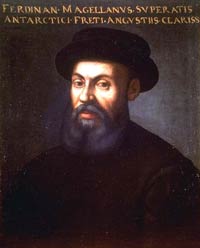
| Born: 1480 in Sabrosa, Trás-os-Montes e Alto Douro, Portugal |
| Died: Apr 27, 1521 (at age 40–41) in Mactan, Philippines |
| Nationality: Portuguese |
| Famous For: First circumnavigation expedition |
Ferdinand Magellan was a Portuguese explorer who led the first sailing expedition to circumnavigate the globe. Magellan also is said to have named the Pacific Ocean “Mar Pacifico,” which translates to “peaceful sea.”
Early Life
His birthplace is disputed, it was possibly at Sabrosa or near Porto in northern Portugal. Magellan’s father was Rodrigo de Magalhães. Following the death of both his parents when he was 10 he then became Queen Leonor’s page at the royal court in Lisbon. As a boy, Magellan studied navigation, cartography, astronomy, and celestial navigation.
Navigator and Explorer
By the time he was in his twenties, Magellan became a member of a Portuguese fleet which was traveling to East Africa. Magellan fought during the Battle of Diu, where the Portuguese military destroyed many Egyptian ships that were in the Arabian Sea. He also explored Malacca, which was located in present-day Malaysia, as well as took part in the conquering of the port in Malacca. Some historians believe that he traveled to the Moluccas, a group of islands in Indonesia, which were once called the Spice Islands. These islands grew were home to valuable spices such as nutmeg and cloves which many European’s desired.
Magellan was wounded when he was working in Morocco, and this injury caused him to walk with a limp for the rest of his life. After he was injured, Magellan was falsely charged with trading unlawfully with the Moors, and in spite of his service to his country he did not receive any employment offers.
In 1517, he relocated to Seville, Spain, so he could provide his skills and abilities to the royal court in Spain. In the next three years he studied many new navigational charts. Magellan learned from the mistakes and also the discoveries that other explorers had made.
Final Years
In 1519, he set out on a voyage to circumnavigate the world with full support from Charles V, the King of Spain. On September 20th, 1519, Magellan sailed from Spain with five ships that were not adequate for sailing the long distances that he proposed. The fleet first traveled to Brazil, then sailed down South America’s coast to Patagonia. An attempted mutiny occurred there, and one ship was destroyed. In spite of this setback, Magellan and his crew continued sailing on with the rest of the vessels.
By October of 1520, he and his crew had already entered the area now referred to as the Strait of Magellan. That part of the journey took over four weeks, and during those weeks one of the ship’s commanders deserted the expedition by sailing back home. In March of 1521, Magellan’s fleet stopped in Guam. On March 17th, he reached Homonhon, an island in the Philippines, along with 150 crew members. There, Magellan took part in a local conflict and he was killed during a battle on April 27th. His body was never recovered.
Juan Sebastián del Cano and the remainder of the crew continued on and completed the expedition to circumnavigate the world. The next year, on September 8th, the rest of Magellan’s fleet arrived in Spain, proving that the world was indeed round. Altogether, approximately two hundred and thirty-two sailors perished on this trip.